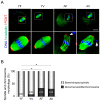Advanced Maternal Age Deteriorates the Developmental Competence of Vitrified Oocytes in Mice
- PMID: 34205802
- PMCID: PMC8234289
- DOI: 10.3390/cells10061563
Advanced Maternal Age Deteriorates the Developmental Competence of Vitrified Oocytes in Mice
Abstract
Advanced maternal age (AMA) is known to be related to the decrease in the quality and quantity of oocytes. Oocyte vitrification is now considered an established assisted reproductive technology for fertility preservation. However, it remains unclear whether the oocytes in older women are more sensitive to various insults during vitrification. Thus, we evaluated whether AMA affects cellular and molecular features and developmental outcomes of oocytes after vitrification in mice. The oocytes were grouped as young fresh (YF), young vitrified/warmed (YV), aged fresh (AF), and aged vitrified/warmed (AV). The survival rate of AV oocytes was significantly lower than that of YV oocytes. The rates of fertilization, cleavage, and blastocyst formation of AV oocytes were significantly lower than those of other groups. AV oocytes were represented as aberrations in mitochondria distribution, microvacuole size, and autophagosome formation, leading to delayed embryo development in mice. This delay was associated with a reduced number of total cells and trophectoderm in the blastocyst developed from AV oocytes. Collectively, AMA exaggerates the vulnerability of oocytes to cryo-damage that occurs during vitrification in mice, suggesting that the current vitrification protocols optimized for oocytes from young females should be modified for oocytes from aged women.
Keywords: advanced maternal age (AMA); developmental competence; fertility preservation; oocyte quality; oocyte vitrification; time-lapse monitoring.
Conflict of interest statement
The authors declare no conflict of interest.
Figures







Similar articles
-
Cryo-survival, fertilization and early embryonic development of vitrified oocytes derived from mice of different reproductive age.J Assist Reprod Genet. 2010 Nov;27(11):605-11. doi: 10.1007/s10815-010-9450-3. Epub 2010 Jul 17. J Assist Reprod Genet. 2010. PMID: 20640502 Free PMC article.
-
Vitrification of in vitro matured oocytes diminishes embryo development potential before but not after embryo genomic activation.J Assist Reprod Genet. 2016 Feb;33(2):231-6. doi: 10.1007/s10815-015-0637-5. Epub 2015 Dec 21. J Assist Reprod Genet. 2016. PMID: 26685678 Free PMC article.
-
A recovery time after warming restores mitochondrial function and improves developmental competence of vitrified ovine oocytes.Theriogenology. 2018 Apr 1;110:18-26. doi: 10.1016/j.theriogenology.2017.12.031. Epub 2017 Dec 26. Theriogenology. 2018. PMID: 29331828
-
Overexpression of signal transducers and activators of transcription in embryos derived from vitrified oocytes negatively affect E-cadherin expression and embryo development.Cryobiology. 2015 Jun;70(3):239-45. doi: 10.1016/j.cryobiol.2015.03.003. Epub 2015 Mar 18. Cryobiology. 2015. PMID: 25794598
-
Effect of vitrification of in vitro matured prepubertal goat oocytes on embryo development after parthenogenic activation and intracytoplasmic sperm injection.Cryobiology. 2020 Apr;93:56-61. doi: 10.1016/j.cryobiol.2020.02.011. Epub 2020 Feb 25. Cryobiology. 2020. PMID: 32109458
Cited by
-
Decreased ATF5 level contributes to improved mitochondrial function in oocytes exposed to vitrification stress.Front Cell Dev Biol. 2024 Sep 20;12:1431683. doi: 10.3389/fcell.2024.1431683. eCollection 2024. Front Cell Dev Biol. 2024. PMID: 39372953 Free PMC article.
-
Mitochondria Transfer from Adipose Stem Cells Improves the Developmental Potential of Cryopreserved Oocytes.Biomolecules. 2022 Jul 21;12(7):1008. doi: 10.3390/biom12071008. Biomolecules. 2022. PMID: 35883564 Free PMC article.
-
Ultra-Fast Vitrification: Minimizing the Toxicity of Cryoprotective Agents and Osmotic Stress in Mouse Oocyte Cryopreservation.Int J Mol Sci. 2024 Feb 4;25(3):1884. doi: 10.3390/ijms25031884. Int J Mol Sci. 2024. PMID: 38339162 Free PMC article.
-
Comparing the effects of a commercial and a prototype vitrification medium on meiotic spindle morphology and survival rate of mouse oocytes.JBRA Assist Reprod. 2022 Aug 4;26(3):500-507. doi: 10.5935/1518-0557.20210117. JBRA Assist Reprod. 2022. PMID: 35261222 Free PMC article.
-
Butylphthalide identified via Samul-tang-induced transcriptomic signatures improves oocyte quality in aged mice.NPJ Aging. 2025 Mar 26;11(1):21. doi: 10.1038/s41514-025-00214-3. NPJ Aging. 2025. PMID: 40140401 Free PMC article.
References
-
- Ubaldi F.M., Cimadomo D., Vaiarelli A., Fabozzi G., Venturella R., Maggiulli R., Mazzilli R., Ferrero S., Palagiano A., Rienzi L. Advanced maternal age in IVF: Still a challenge? The present and the future of its treatment. Front. Endocrinol. 2019;10:94. doi: 10.3389/fendo.2019.00094. - DOI - PMC - PubMed
-
- Johnston M., Richings N.M., Leung A., Sakkas D., Catt S. A major increase in oocyte cryopreservation cycles in the USA, Australia and New Zealand since 2010 is highlighted by younger women but a need for standardized data collection. Hum. Reprod. 2020;36:624–635. doi: 10.1093/humrep/deaa320. - DOI - PubMed
Publication types
MeSH terms
Grants and funding
LinkOut - more resources
Full Text Sources

